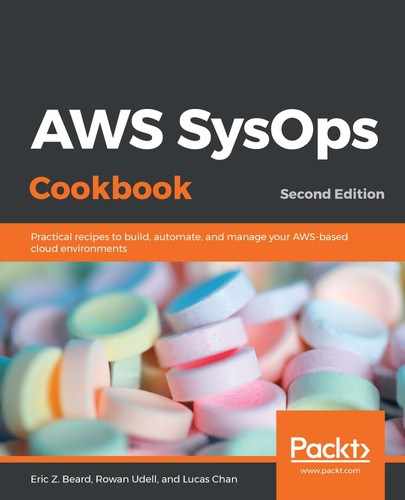Follow these steps to create a lambda function, and a custom resource that makes use of that function, in order to create an S3 bucket:
- Log in to your account, and go to the Lambda console.
- Click Create function, and choose the Author from scratch.
- Give your function a unique, descriptive name.
- Choose Node.js 8.10 as the Runtime:

The Lambda console allows you to author a function from scratch, or choose from a variety of templates
- Create a custom role by clicking on the IAM console link. A new screen opens, where you can create the role that will be associated with the lambda function. Give it a descriptive name.
- Click Edit to customize the policy. You need to give the lambda function permissions to write to CloudWatch logs, and also give it permission to administer the S3 bucket. Paste in the following code:
{
"Version": "2012-10-17",
"Statement": [
{
"Effect": "Allow",
"Action": [
"logs:CreateLogGroup",
"logs:CreateLogStream",
"logs:PutLogEvents"
],
"Resource": "arn:aws:logs:*:*:*"
},
- Continue with the statement that provides the S3 permissions:
{
"Effect": "Allow",
"Resource": [
"arn:aws:s3:::*",
"arn:aws:s3:::*/*"
],
"Action": [
"s3:CreateBucket",
"s3:DeleteBucket",
"s3:PutObject",
"s3:DeleteObject"
]
}
]
}
- Click Allow, in order to associate the new role with the lambda function.
- Back on the Lambda console, click Create function, and paste the following code into the function code editor for index.js. This code sample continues over several blocks. Start with the required imports and constants:
/**
* This is a custom resource handler that creates an S3 bucket
* and then populates it with test data.
*/
var aws = require("aws-sdk");
var s3 = new aws.S3();
const SUCCESS = 'SUCCESS';
const FAILED = 'FAILED';
const KEY = 'test_data.csv';
- Continue with the definition of the handler function:
exports.handler = function(event, context) {
console.info('mycrlambda event', event);
// When CloudFormation requests a delete,
// remove the object and the bucket.
if (event.RequestType == "Delete") {
let params = {
Bucket: event.ResourceProperties.BucketName,
Key: KEY
};
- Continue with the code that implements a delete request:
s3.deleteObject(params, function(err, data) {
if (err) {
console.log(err, err.stack);
sendResponse(event, context, FAILED);
} else {
console.log('Deleted object', data);
let params = {
Bucket: event.ResourceProperties.BucketName
};
s3.deleteBucket(params, function(err, data) {
if (err) {
console.log(err, err.stack);
sendResponse(event, context, FAILED);
} else {
console.log("Deleted bucket", data);
sendResponse(event, context, SUCCESS);
}
});
}
});
return;
}
- We don't take any action for an update:
if (event.RequestType == "Update") {
// Nothing to do here
sendResponse(event, context, SUCCESS);
return;
}
var params = {
Bucket: event.ResourceProperties.BucketName
};
- Create the bucket in response to a create request:
s3.createBucket(params, function(err, data) {
if (err) {
console.log(err, err.stack);
sendResponse(event, context, FAILED, data);
} else {
console.log('Created bucket ' +
event.ResourceProperties.BucketName);
// Now that we have created the bucket, populate it with test data
params = {
Body: '1,"A"
2,"B"
3,"C"',
Bucket: event.ResourceProperties.BucketName,
Key: KEY
};
s3.putObject(params, function(err, data) {
if (err) {
console.log(err, err.stack);
sendResponse(event, context, FAILED, data);
} else {
console.log('Created object test_data.csv');
sendResponse(event, context, SUCCESS, data);
}
});
}
});
};
- Declare the following function to send responses back to the S3 signed URL, which is monitored by CloudFormation:
/**
* Send a response to the signed URL provided by CloudFormation.
*/
function sendResponse(event, context, status, data) {
var body = JSON.stringify({
Status: status,
Reason: "",
PhysicalResourceId: context.logStreamName,
StackId: event.StackId,
RequestId: event.RequestId,
LogicalResourceId: event.LogicalResourceId,
Data: data
});
- Continue the sendResponse function:
console.log("body: ", body);
var https = require("https");
var url = require("url");
var parsedUrl = url.parse(event.ResponseURL);
var options = {
hostname: parsedUrl.hostname,
port: 443,
path: parsedUrl.path,
method: "PUT",
headers: {
"content-type": "",
"content-length": body.length
}
};
- End the function by making the HTTPS request:
var request = https.request(options, function(response) {
console.log("response.statusCode: " +
response.statusCode);
console.log("response.headers: " +
JSON.stringify(response.headers));
context.done();
});
request.on("error", function(error) {
console.log("sendResponse Error:" + error);
context.done();
});
request.write(body);
request.end();
}
- Click Save to the function. Copy the Amazon Resource Name (ARN) at the top right of the screen:

Copy the function ARN
- Now that you have created a lambda function that will execute your custom logic, go to the CloudFormation console.
- Create a file on your filesystem (the name doesn't matter, but you should give it a .yaml extension) with the following content:
AWSTemplateFormatVersion: "2010-09-09"
Parameters:
MyFunctionArn:
Type: String
Description: The ARN of the lambda function
MyBucketName:
Type: String
Description: The name of the bucket to create
Resources:
MyCustomResource:
Type: Custom::CreateBucketWithData
Version: "1.0"
Properties:
ServiceToken: !Ref MyFunctionArn
BucketName: !Ref MyBucketName
- In the CloudFormation console, click Create Stack. Select Upload a template to Amazon S3, and upload the file.
- Give the stack a unique name, and paste the ARN from the function that you created earlier into the MyFunctionArn parameter textbox. In the MyBucketName parameter textbox, enter a globally unique name for the bucket that is to be created by your lambda function:

Stack details
- Click through the next two screens, and then click Create. It might take a few minutes for the stack to finish. You can watch its progress on the CloudFormation console.
- Once the stack is complete, go to the S3 console to confirm that the custom resource has successfully created the bucket, and the test data file within the bucket:

Bucket overview screen
- Delete the stack and the lambda function, so that you are left with a clean environment. This will avoid any unexpected costs in the future.
